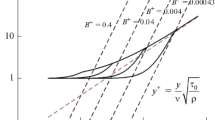Abstract
The Oriented-Eddy Collision (OEC) model treats turbulent flow as a non-Newtonian fluid where the average behavior of turbulence is modeled as a collection of interacting fluid particles which have inherent orientation. The model is derived from the two-point velocity correlation transport equation, and has the form of a collection of Reynolds-stress transport equations, with one set of transport equations for each representative eddy direction. The addition of eddy orientation information adds important physics to the model and allows the model to represent structural (two-point) information about the turbulence. This structural information is sufficient to allow the model to capture the effect of external forces and imposed mean strains (such as rapid distortion theory) exactly. The only physical effects that must be empirically modeled are those that are due to turbulence-turbulence interactions, referred to as eddy collisions. The performance of the model in a number of canonical flow situations is presented.
Similar content being viewed by others
References
Reynolds, W.C.: Effects of rotation on homogeneous turbulence. In: Proceedings of the 10th Australian Fluids Mechanics Conference, pp. KS 2.1–2.6. Melbourne (1989)
Perot, J.B.: Turbulence modeling using body force potentials. Phys. Fluids 11(9), 2645–2656 (1999)
Kassinos, S.C., Reynolds, W.C.: One-point modeling of rapidly deformed homogeneous turbulence. Proc. R. Soc. London A 451, 87–104 (1995)
Reynolds, W.C., Kassinos, S.C.: A particle representation model for the deformation of homogeneous turbulence. Center for Turbulence Research, Stanford University/NASA Ames Research Center (1996)
Akylas, E., Kassinos, S.C.: Advances in particle representaiton modeling of homogeneous turbulence. From linear PRM version to the nteracting viscoelastic IPRM. In: ERCOFTAC: New Approaches in Modeling Multiphase Flows and Dispersion Turbulence, Fractal Methods, and Synthetic Turbulence, vol. 18 (2011)
Pope, S.B. Van Sloten, P.R.: PDF modeling for inhomogeneous turbulence with exact representation of rapid distortions. Phys. Fluids 9(4), 1085–1105 (1996)
Jasak, H.: Error analysis and estimation for the finite volume method with applications to fluid flows. Imperial College of Science, Technology and Medicine, London, England, Ph.D. Thesis (1996)
Rusche, H.: Computational fluid dynamics of dispersed two-phase flows at high phase fractions. Ph.D. thesis, Imperial College of Science, Technology and Medicine, London, England (2002)
Lumley, J.L., Tennekes, H.: A First Course in Turbulence. Cambridge, Massachusetts (1972)
Pope, S.B.: Turbulent Flows. Cambridge University Press, New York (2000)
Deissler, R.G.: Problem of steady state shear flow turbulence. Phys. Fluids 8(3), 391–398 (1965)
de Bruyn Kops, S.M., Perot, J.B.: Modeling turbulent dissipation at low and moderate Reynolds numbers. J. Turbul. 7(69), 1–14 (2006)
Saffman, P.G.: On the spectrum and decay of random two-dimensional vorticity distributions at large Reynolds number. Stud. Appl. Math. 50, 377–383 (1971)
Saffman, P.G.: The large-scale structure of homogeneous turbulence. J. Fluid Mech. 27(3), 581–593 (1967)
Perot, J.B.: Determination of the decay exponent in mechanically stirred isotropic turbulence. AIP Adv. 1, 022104:1–18 (2011)
Chartrand, C., Perot, J.B.: Modeling return to isotropy using kinetic equations. Phys. Fluids 17, 035101-1 (2005)
Rotta, J.: Statistische Theorie nichthomogener turbulenz. Z. Phys. A-Hadron Nucl. 129(6), 547–572 (1951)
Mininni, P.D., Teitelbaum, T.: The decay of turbulence in rotating flows. Phys. Fluids 23, 065105:1–15 (2011)
Chartrand, C.C.: Eddy collision models for turbulence. Masters thesis, The University of Massachusetts, Amherst (2005)
Riley, J.J., de Bruyn Kops, S.M.: Direct numerical simulation of laboratory experiments in isotropic turbulence. Phys. Fluids 10, 2125–2127 (1998)
Nagib, H.M., Wigeland, R.A.: Effects of rotation on decay of turbulence. Bull. Am. Phys. Soc. 23, 998 (1978)
Leuchter, O., Cambon, C., Mathieu, J., Jacquin, L.: Homogeneous turbulence in the presence of rotation. J. Fluid Mech. 220, 1–52 (1990)
Cambon, C., Speziale, C.G., Mansour, N.N.: Theoretical and computational study of rotating isotropic turbulence. In: Sarkar, S., Speziale, C.G., Gatski, T.B. (eds.) Studies in Turbulence. Springer-Verlag (1992)
Reynolds, W.C., Lee, M.J.: Numerical experiments on the structure of homogeneous turbulence. Thermosciences, Deparment of Mechanical Engineering, Stanford University, TF-24 (1985)
Reynolds, W.C., Rogers, M.M., Kassinos, S.C.: One-point turbulence structure tensors. J. Fluid Mech. 428, 213–248 (2001)
Reynolds, W.C., Kassinos, S.C.: A Structure-Based Model with Stropholysis Effects. Center for Turbulence Research Annual Research Briefs (1998)
Gence, J.N., Comte-Bellot, G. Le Penven, L.: On the approach to isotropy of homogeneous turbulence: effect of the partition of kinetic energy among the velocity components. In: Davis, S.H., Lumley, J.L. (eds.) Frontiers in Fluid Mechanics, p. 1. Springer (1984)
Nagano, Y., Tsuji, T., Matsumoto, A.: Direct numerical simulation of homogeneous turbulent shear flow. In: 5th Symposium on Computational Fluid Dynamics, pp. 361–364 (1991)
Author information
Authors and Affiliations
Corresponding author
Rights and permissions
About this article
Cite this article
Martell, M.B., Perot, J.B. The Oriented-Eddy Collision Turbulence Model. Flow Turbulence Combust 89, 335–359 (2012). https://doi.org/10.1007/s10494-012-9395-y
Received:
Accepted:
Published:
Issue Date:
DOI: https://doi.org/10.1007/s10494-012-9395-y




